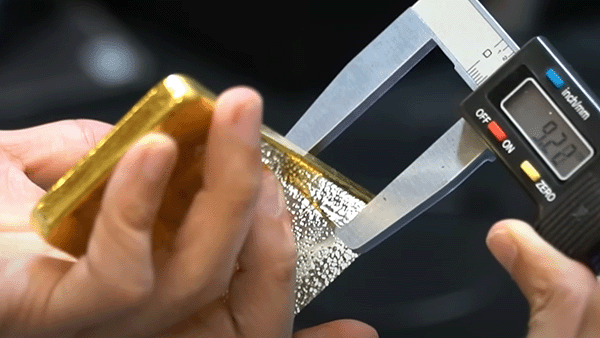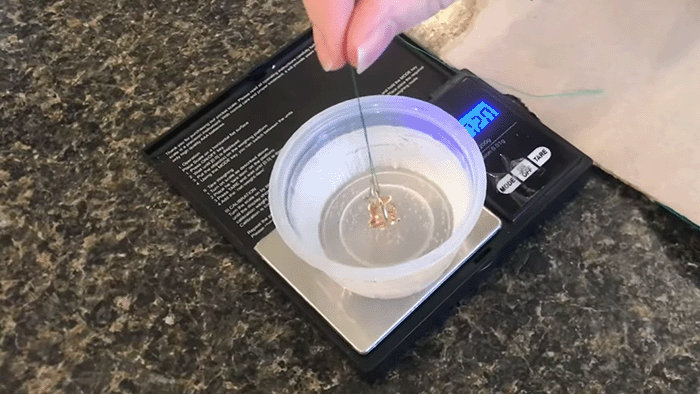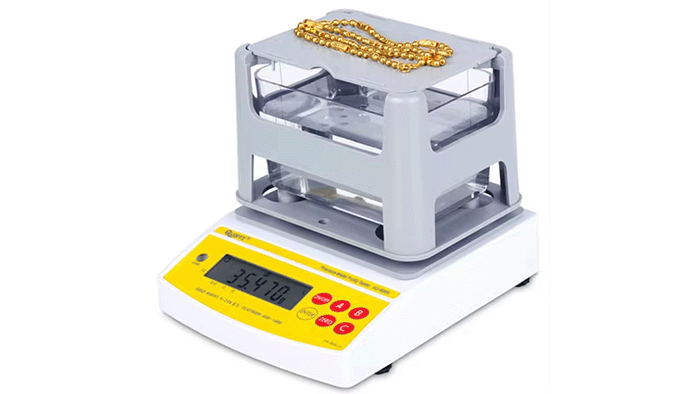Testing Gold With a Specific Gravity or Density Test
30 July 2024

There are many ways to test whether a gold coin or bar is real. While a destructive test like a fire assay is often held as the surest way, there are many non-destructive gold testing methods today that preserve that gold bar or coin.
These testing methods include X-ray Fluorescence (XRF), ultrasound, electrical conductivity measurement, and magnetic tests. However, one of the most common and simplest gold testing methods is the density test.
Density is the amount of mass in a unit volume of a substance. Gold is considered a dense metal, and its density is recorded at 19.32 g/cm3. During the gold rushes between the 18th and 19th centuries, where some of the biggest gold nuggets in history were found, the density of gold was critical in the gold panning process. Gold prospectors would station themselves by a river bed, scooping gravel and sand using the modest frying pan. They swirl the pan to remove the gravel and sand, leaving heavier materials, like gold. With gold’s unique golden metallic luster, small gold deposits could easily be spotted by the naked eye.
Is Density the Same as Specific Gravity?
Before we describe the process of testing gold with a density test, it is important to understand if density is the same as specific gravity, since there are specific gravity tests for gold as well, and they produce the same numerical results as a gold density test.
While density and specific gravity are used to describe mass, they are not identical.
As mentioned previously, density is a measure of how much is contained in a given volume and is expressed in units like grams per cubic centimeter (g/cm3) or kilograms per cubic meter (kg/m³). Gold’s density is measured at 19.32 g/cm3.
On the other hand, specific gravity is a dimensionless number that compares a substance’s density to a reference substance’s density, typically water (which is 1 g/cm³ at 4°C). Gold’s specific gravity is also 19.32 because the density of gold is 19.32 times that of water.
Therefore, density is a unit of measurement, while specific gravity is a comparison between substances.
How Gold’s Density is Affected by Temperature
Gold’s density can be affected by temperature as a result of thermal expansion. As metals get hotter, they expand, and their density decreases.
While gold’s density is 19.32 at room temperature, it falls to 18.31 at just below its melting point of 1064 °C. Should the temperature rise to just above the melting point, gold becomes molten, having a density of 17.19. As molten gold cools and solidifies, it experiences a 6% volume reduction, gradually bringing the density back to 19.32 at room temperature.
How Gold’s Density is Tested
The following are different ways to test for gold’s density.
#1 – Measuring the Dimensions of a Gold Bar or Coin
If you own gold bullion bars or coins, the refiner often publishes their dimensions (length, width, and depth) and weight. You can easily verify both measurements using a digital caliper and a weighing scale.

#2 – Performing a Specific Gravity Test
Measuring gold’s dimensions may not be feasible for odd-shaped gold like gold jewelry and pendants. In such cases, you can perform a specific gravity test instead.
You will need a highly accurate precision scale, preferably able to measure up to two decimal places, to measure minute weight variations. Next, fill a container with water. This container should be large enough to completely submerge the gold item to be tested without any contact with the gold. For example, if you are testing a gold pendant or coin, a plastic drinking cup will suffice.
Then, weigh the gold item on the scale and record its weight. Next, place the water-filled container on the scale and press “tare” to zero the scale’s display.
Tie the gold item with a string. Then, submerge the gold in the water-filled container. Record the new reading on the scale.

Calculate the specific gravity of gold by dividing the item's weight by its suspended-in-water weight. The closer the value is to 19.3, the higher the purity of the gold item. Conversely, a significantly lower value will indicate lower gold purity, possibly due to the presence of other metals or gold alloys.
#3 – Using a Gold or Carat Balance
Besides manufacturing weighing scales, the measurement solutions industry also produces gold or carat balances to measure the density of small items like gold jewelry.
Gold balances work on the same principles as the aforementioned specific gravity test, except that they are commercially produced equipment. Also able to perform as a precision scale, some gold balances require an additional density kit for density measurement. Newer models may have built-in functions to calculate the purity of gold. For example, 24k is pure gold.
However, gold balances are much more expensive than the aforementioned specific gravity method for testing gold. The size of the gold item that can be tested may also be limited by the gold balance's water container.

Never Rely on a Single Gold Testing Method
Now that you have a better understanding of density tests for gold, it is important that you never rely on a single method to test gold.
The most common way to counterfeit gold is to substitute another metal with the closest density to gold before applying a gold-plated layer. Tungsten, cheaper than gold, is often used to fake gold, given its close density at 19.25 g/cm3.
Due to the closeness of gold’s and tungsten’s densities, a counterfeit gold-plated bar with a tungsten core may fool novices who do not detect the minute differences in dimensions and weight.
While gold counterfeiters may be able to fake one material property, such as density, it is significantly harder to fake two or more properties. Adding an additional non-destructive gold testing method, such as X-ray Fluorescence (XRF), ultrasound, electrical conductivity measurement, or magnetic test, will increase the chances of detecting fake gold jewelry and bullion, or even a gold alloy.
Having operated our precious metal testing laboratory at The Safe House vault for over a decade, we have encountered fake gold bars optimized to bypass different precious metal tests, such as density or electrical conductivity tests. Therefore, we cannot emphasize enough the importance of using more than one test when authenticating gold.
Testing Precious Metals With The Safe House
The Safe House is a forerunner of non-destructive testing methods for precious metals. We have tested millions of troy ounces of gold, silver, and platinum over the years for our clients. Our precious metal testing laboratory employs up to five different types of tests as part of our testing process. Below is a video explaining these five non-destructive precious metal testing method used in our vault.
Our wealth of experience in testing gold, platinum and silver has made The Safe House one of Asia's leading precious metal testing centers.
Contact us for information on non-destructive precious metal testing methods.